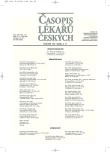Nicotinic Acid: An Unjustly Neglected Remedy
Kyselina nikotinová: lék neprávem opomíjený
Podávání kyseliny nikotinové (niacinu) vede v lidském organizmu ke dvěma typům účinků. Ve fyziologických dávkách (≈20 mg/den) plní funkci vitaminu jako faktor bránící rozvoji pelagry. Ve farmakologických dávkách (≈0,5–4,5 g/den) výrazně ovlivňuje koncentrace plazmatických lipidů a lipoproteinů: Snižuje koncentrace VLDL a LDL, mění profil subfrakcí LDL směrem k zastoupení částic o větší velikosti a nižší denzitě a výrazně zvyšuje koncentraci HDL, hlavně v důsledku elevace subfrakce HDL2. Jako jediné hypolipidemikum snižuje také koncentrace lipoproteinu (a). Mechanizmus hypolipidemického účinku odlišuje niacin od ostatních skupin hypolipidemik. Na základě analýz klinicky kontrolovaných studií (epidemiologických intervenčních i angiografických), které splňují kritéria medicíny založené na důkazech, lze konstatovat, že niacin patří jednoznačně mezi hypolipidemika s prokázaným příznivým účinkem nejen na kardiovaskulární mortalitu a morbiditu, ale i celkovou mortalitu. Proto by měl mít nezpochybnitelné místo ve farmakologické kontrole dyslipidémií. Vzhledem k základnímu mechanizmu účinku (inhibice lipolýzy tukové tkáně) s následným poklesem koncentrace volných mastných kyselin a jejich toku do jater, splňuje niacin kritéria patogenetické léčby aterogenní dyslipidémie u metabolického syndromu. Nutným předpokladem léčby niacinem je respektování vedlejších účinků i možných rizik jeho podávání (flush, hepatotoxicita a deteriorace homeostázy glukózy). Nově zjištěné extrahypolipidemické účinky niacinu (antioxidační působení, potenciace reverzního transportu cholesterolu, aktivace PPAR-γ, antitrombotické účinky) a zavedení lékových forem s řízeným uvolňováním aktivní látky (minimalizující vedlejší účinky a rizika podávání) jsou fakta, která opodstatňují názor, že deriváty kyseliny nikotinové by měly být v České republice opětovně zavedeny do klinické praxe.
Klíčová slova:
niacin, flush, deteriorace glukózové homeostázy, hepatotoxicita, inhibice lipolýzy, hypolipidemické účinky, změny kardiovaskulární morbidity a mortality, řízené uvolňování.
Authors:
A. Žák; M. Zeman; M. Vecka; E. Tvrzická
Authors‘ workplace:
IV. interní klinika 1. LF UK a VFN, Praha
Published in:
Čas. Lék. čes. 2006; 145: 825-831
Category:
Review Article
Overview
In human organism, the administration of nicotinic acid (niacin) leads to two types of effects. Within the physiological range (≈20 mg/day), niacin has a vitamin-like role as pellagra preventing factor. The pharmacological dosage (≈0,5-4,5 g/day) substantially influences the plasma lipid and lipoprotein concentrations: decreases VLDL and LDL concentrations, changes the profile of LDL subfractions towards the larger particles as well as particles with lower density; it also profoundly increases the concentration of HDL-C in consequence of elevated concentration of HDL2 subfraction. Niacin as the only hypolipidemic drug reduces the lipoprotein(a) concentration. The hypolipidemic mechanism of niacin is different from that of other hypolipidemic drugs. On the basis of clinically controlled trials (both interventional epidemiological and angiographical), which satisfy the criteria of evidence-based medicine, it is possible to conclude that niacin falls unambiguously into the class of hypolipidemic drugs with proven beneficial effect not only on cardiovascular mortality and morbidity, but also on total mortality. Therefore, niacin should have an indisputable role in the pharmacological control of dyslipidemias. With the respect of basic mechanism (inhibition of the lipolysis of adipose tissue) with subsequent decrease in the concentration of free fatty acids and their flux to liver, niacin fulfils the criteria for pathogenetic treatment of atherogenic dyslipidemia in metabolic syndrome. The prerequisite condition for the niacin treatment is the respect for serious adverse effects and possible health hazards of administration (skin flush, hepatotoxicity and deterioration of glucose homeostasis). Recently discovered extrahypolipidemic effects of niacin (antioxidative activity, facilitation of reverse cholesterol transport, activation of PPAR-γ, antithrombotic effects) and the introduction of drug forms with sustained (extended resp.) release of active compound (that minimizes the adverse effects and administration hazards) form together the basis for firm statement that the derivatives of nicotinic acid should be introduced to the clinical practice in Czech Republic.
Key words:
niacin, flush, deterioration of glucose homeostasis, hepatotoxicity, inhibition of lipolysis, hypolipidemic effects, changes in cardiovascular morbidity and mortality, sustained (extended resp.) release.
Labels
Addictology Allergology and clinical immunology Angiology Audiology Clinical biochemistry Dermatology & STDs Paediatric gastroenterology Paediatric surgery Paediatric cardiology Paediatric neurology Paediatric ENT Paediatric psychiatry Paediatric rheumatology Diabetology Pharmacy Vascular surgery Pain management Dental HygienistArticle was published in
Journal of Czech Physicians

- Metamizole at a Glance and in Practice – Effective Non-Opioid Analgesic for All Ages
- Metamizole vs. Tramadol in Postoperative Analgesia
- The Importance of Limosilactobacillus reuteri in Administration to Diabetics with Gingivitis
- The Importance of Hydration in Wound Healing
Most read in this issue
- Nicotinic Acid: An Unjustly Neglected Remedy
- Mean Platelet Volume (MPV) in Crohn’s Disease Patients
- Our First Experience with CT Enteroclysis
- Contemporary Non-invasive Aesthetic Medicine
